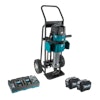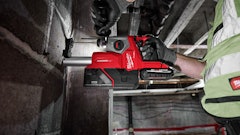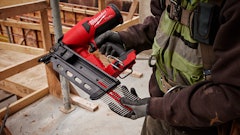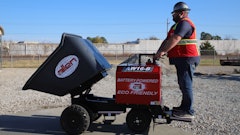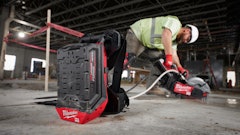
Lithium batteries have become indispensable in the construction industry, powering everything from handheld tools such as cutoff saws and drills to larger equipment such as scissor lifts and track loaders. High energy density, lightweight design and efficiency make them the preferred choice over older technologies. They offer contractors significant advantages in mobility and productivity. The use of these batteries is growing rapidly, with the global demand expected to increase seven-fold by 2030.
On jobsites, lithium batteries support lightweight, portable tools while delivering the energy needed for demanding tasks. Their compact size, fast charging ability, and cold weather tolerance make them ideal for keeping up with tight schedules. Larger battery systems used in heavy equipment also reduce reliance on traditional fuels to lower costs and emissions. These capable batteries bring tremendous value along with new challenges for safety that can’t be ignored.
Unique Risks of Lithium Batteries
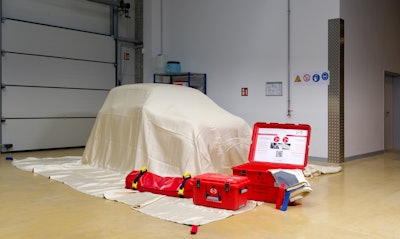 In the event of a lithium battery fire, specially treated fire blankets smother the fire and keep it from spreading until first responders arrive.DENIOS
In the event of a lithium battery fire, specially treated fire blankets smother the fire and keep it from spreading until first responders arrive.DENIOS
Most issues with lithium batteries aren’t random. They stem from predictable causes that are most often linked to handling or charging practices. Understanding these common causes emphasizes the importance of proper handling, storage, and quality control. Strong prevention and precautionary safety measures greatly reduce the risks.
- Electrical overload is a common concern. Using non-original chargers or trying to recharge batteries that are deeply discharged can lead to problems. Overcharging generates excessive heat, pushing the battery beyond its limits and increasing the likelihood of failure.
- Mechanical damage is another common cause. Batteries can sustain serious internal damage when dropped, crushed, or impacted during handling or transport. Even if the damage is not immediately visible, deformed cells increase the likelihood of internal short circuits, which can lead to fires.
- Thermal stress is another serious concern. Storing batteries in direct sunlight, near heat sources, or in enclosed, poorly ventilated spaces can lead to overheating. Overheated batteries are at risk for thermal runaway, the dangerous chain reaction discussed earlier. Defective products can also contribute to incidents.
- Contamination during manufacturing or other flaws in the battery can create internal short circuits, leading to fires or explosions. Defects can be hidden and only become hazardous under certain conditions, such as exposure to high temperatures, impact from being dropped or crushed, or overcharging during the charging process.
- Water poses an additional problem. Whether batteries are left outside, submerged, or simply exposed to high humidity, moisture can compromise their internal structure. This can lead to corrosion, short circuits, or chemical reactions that increase the risk of fire or failure.
Safety For Usage, Charging & Storage
 BatterySafe cases feature cushions filled with PyroBubbles - an extinguishing agent which provides protection against thermal runaway and exothermic reactions.DENIOS
BatterySafe cases feature cushions filled with PyroBubbles - an extinguishing agent which provides protection against thermal runaway and exothermic reactions.DENIOS
Charging is one of the most critical, high-risk times of lithium battery operation. It can quickly become a dangerous situation without proper precautions in place. Batteries should never be charged near combustible materials or in unventilated spaces, as the heat generated during charging can easily ignite nearby flammable objects or create hazardous conditions in confined areas. Charging should always be done under supervision. For charging overnight, or other times when staff aren’t present, it’s essential to use systems equipped with built-in smoke detectors, temperature sensors, and alarms. These safety features can ensure issues are identified and addressed before they escalate. Professional grade, fire-safe charging cabinets that provide 90 minutes of fire protection from within or without are especially important given that a conventional fire may ignite batteries. Designed with fire-resistant materials and built-in ventilation, these cabinets effectively prevent heat buildup. They are particularly useful when needing to charge multiple batteries at once because they help manage the added heat. Greater quantities of batteries or larger battery modules may benefit from a 2-hour fire resistance locker or building due to the larger energy payload risk. A combination of precautions and the right equipment work together to minimize threats during the charging process.
Safe battery storage forms the basis of risk prevention. To reduce the potential for accidents, it’s vital to keep a structural separation of at least 8 ft. (2.5 meters) between stored batteries and any other flammable materials, particularly if there is no automatic extinguishing system in place. Specialized fire-safe storage cabinets made for batteries are an excellent choice. These types of cabinets provide two-way fire resistance, spill containment, and self-closing doors, all features created to prevent hazards from spreading. Damaged batteries pose an even greater risk and should be moved to designated, fire-rated containers far away from other work areas to maintain safe operations.
Detecting & Handling Damaged Lithium Batteries
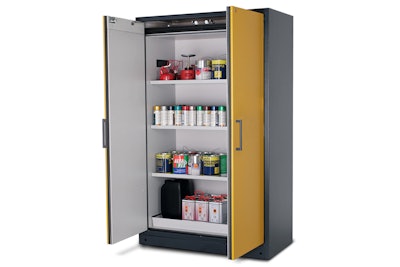 Fire safe cabinets have two way fire protection to keep internal contents from igniting in case of an external fire, and keep the fire from spreading to the facility in case of an internal fire.DENIOS
Fire safe cabinets have two way fire protection to keep internal contents from igniting in case of an external fire, and keep the fire from spreading to the facility in case of an internal fire.DENIOS
Smell tests can also help identify issues. Unusual odors, including the smell of burning plastic or chemicals, could indicate internal damage. However, note that with new tools, some odors may occur due to residual manufacturing substances, not necessarily battery defects.
In-device checks and charging tests are equally important. If a battery fails to function in multiple devices, displays errors, or is not recognized by its charger, it may be compromised. When charging, monitor for malfunctions such as failure to charge or error messages from the unit.
When a damaged or defective battery is identified, swift action is necessary. The battery should be removed from use, disconnected from the device, and isolated in a fire-rated enclosure. Under no circumstances should anyone attempt to repair it. To avoid an incident, the battery should be isolated it a secure spot, and any exposed contacts should be masked to help prevent short circuits. Lithium battery fires don’t respond to traditional suppression methods such as water or foam. Specially formulated powders or granules designed for Class D fires, or special lithium fire blankets are required. These materials work by absorbing heat and creating a barrier that cuts off the oxygen to extinguish the flames and contain the danger. Disposal by a professional hazardous materials specialist is recommended.
Planning for Minimized Risk
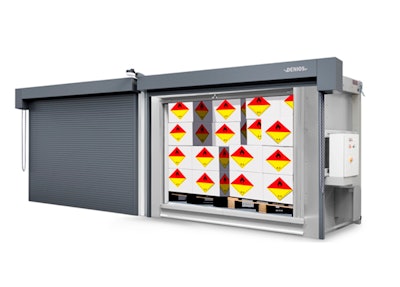 RFP Storage buildings provide safe storage for large quantities of lithium batteries and are ideal for batteries for larger equipment such as loaders, excavators, material handlers, and more.DENIOS
RFP Storage buildings provide safe storage for large quantities of lithium batteries and are ideal for batteries for larger equipment such as loaders, excavators, material handlers, and more.DENIOS
Batteries are helping revolutionize the construction industry. They drive tools and equipment that boost productivity while also reducing environmental impact. This transformation comes with a responsibility to understand the risks and adopt comprehensive safety measures. When they are informed and prepared, contractors can take advantage of new technology and protect their teams and projects at the same time.



